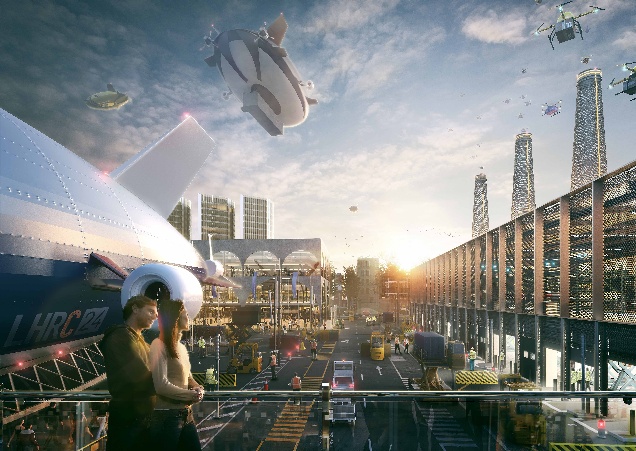Forget their sci-fi image: airships really could be the answer for Heathrow in a post-airport future, says Hawkins Brown’s Darryl Chen
Imagine the sky above London dotted with softly humming airships. Half floating, half jet-propelled, they make for a spectacle as familar and surreal as a dream. You recall the skies used to be streaked with vapour trails and resound with that delayed roar of aeroplanes? They’ve long been banished to somewhere in the estuary, while a new creature has taken its place over central London…
Fanciful? Not say manufacturers betting serious R&D money on airship technologies. Not say the UK government who have invested in airship development, or Hybrid Air Vehicles who plan commercial freight services by 2021. Airships are currently being deployed around the world for scientific missions, humanitarian efforts and even surveying natural disasters. The question of airships in the mainstream is not a matter of if but when.
Airships are becoming faster and quieter, they carry heavier payloads and, importantly, are carbon fuel-efficient. Current models emit 1/7 the carbon of a 787, with half the noise. Ballasts keep them stable in rough weather and they are filled with inert helium which is non-flammable. They benefit from vertical take-off and landing, and can dock in any small field with two ground staff.
Hawkins Brown’s airship port proposal
We have imagined they might take on some of the freight transportation were Heathrow to be decommissioned. The plan would consolidate logistics infrastructure already in place at Heathrow and in west London, and go some way to addressing the void of economic activity in the wake of the airport moving.
Airships will fundamentally alter the geography of distribution, in alleviating congestion on road and rail networks and in reaching both more remote and more built-up areas. (Could this be the lifeline to the north that HS2 is mooted to be?) Some 920 million parcels were dispatched from UK e-retailers in 2013 making Britons the biggest online shoppers in the world. The smooth distribution of goods underpins modern life. It underwrites our material securities. This is the stuff urbanism is made of.
Sure, we should be consuming less. But as long as we are consuming, let’s do it greener. Low carbon-emission airship freight might form an ethical brand, comparable to fairtrade or organic. A cost premium can be added at the point of sale when dealing in comparison goods. And let’s not forget that if we’re still in the EU then they will increasingly be on our back about enforcing emissions cuts.
If airships are the whales, then drones are the mosquitoes. What other creatures will inhabit this airborne ecosystem of the near future?
Source: bdonline.co.uk


Airship will reign the sky again - steampunks we can hope!
ReplyDelete